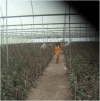Low levels of knowledge and practice of occupational hazards among flower farm workers in southwest Shewa zone, Ethiopia: a cross-sectional analysis
- PMID: 33509148
- PMCID: PMC7844994
- DOI: 10.1186/s12889-021-10254-5
Low levels of knowledge and practice of occupational hazards among flower farm workers in southwest Shewa zone, Ethiopia: a cross-sectional analysis
Abstract
Background: Over the last decade, flower farms have been rapidly growing in Ethiopia. Following the advent and development of the sector, various work-related chemical, biological, physical, psychosocial, and ergonomic hazards have been emerging unacceptably, with increased risks of exposures for workers and local communities. However, evidence that describes knowledge and prevention practice of occupational hazards among flower farm workers in the country is little documented. The knowledge and safety practice of occupational hazards among flower farm workers in Ethiopia were explored in the current study.
Methods: A cross-sectional survey of 471 flower farm workers was implemented from March to April 2017. A stratified random sampling technique was used to select the eligible participants. An interviewer-administered questionnaire was used to collect data, and the data were entered in to Epi Info program version 7 and analyzed by SPSS program version 20. Bivariate and multivariate linear regression analyses were performed to evaluate significance of associations at < 0.05 p-values.
Results: A total of 451 flower farm workers were interviewed with a response rate of 95.7%. The majority, 72.1% (N = 325) were females. Mean age was 24.1 (SD + 6.5) years. About 39.2% (N = 177) of the participants had good knowledge on occupational hazards. The level of safety practice was 26.6% (N = 120). The level of knowledge on occupational hazards was affected by level of education [AOR: 20.03;95% CI (16.30,23.75)], work experience [AOR: 5.97; 95% CI (4.22,7.72)], and type of employment [AOR: 5.35; 95% CI (2.50,8.19)], whereas the level of safety practice was influenced by regular use of personal protective equipment (PPE) [AOR:17.53;95% CI (13.36,21.71)], level of knowledge [AOR: 7.29; 95% CI (3.87,10.73)], and provision of appropriate PPE [AOR: 4.59; 95% CI (2.34,8.86)].
Conclusion: This study revealed the levels of knowledge and safety practice towards occupational hazards were low. The knowledge on occupational hazards was significantly affected by the level of education and duration of employment. Moreover, the use of PPE and level of knowledge considerably influenced safety practice. Therefore, we recommend employers to ensure that workplace health and safety programs account for workers' level of education and work experience. It is also pivotal to provide workers witha suitable PPE and instructions on its use, and to arrange safety communication in the local languages at the relevant workplaces.
Keywords: Ethiopia; Flower farms; Knowledge; Occupational hazards; Practice.
Conflict of interest statement
The authors declare that there are no competing interests.
Figures
Similar articles
-
Respiratory symptoms related to flour dust exposure are significantly high among small and medium scale flour mill workers in Ethiopia: a comparative cross-sectional survey.Environ Health Prev Med. 2021 Sep 29;26(1):96. doi: 10.1186/s12199-021-01019-y. Environ Health Prev Med. 2021. PMID: 34587904 Free PMC article.
-
Awareness of Occupational Hazards and Utilization of Safety Measures among Welders in Aksum and Adwa Towns, Tigray Region, Ethiopia, 2013.J Environ Public Health. 2019 Jan 21;2019:4174085. doi: 10.1155/2019/4174085. eCollection 2019. J Environ Public Health. 2019. PMID: 30805014 Free PMC article.
-
Utilization of personal protective equipment and associated factors among building construction workers in Addis Ababa, Ethiopia, 2019.BMC Public Health. 2020 May 27;20(1):794. doi: 10.1186/s12889-020-08889-x. BMC Public Health. 2020. PMID: 32460738 Free PMC article.
-
Evaluation of an Occupational Safety and Health Training for Cannabis Cultivation Workers.Ann Work Expo Health. 2020 Aug 6;64(7):765-769. doi: 10.1093/annweh/wxaa026. Ann Work Expo Health. 2020. PMID: 32185387 Free PMC article. Review.
-
Environmental and Health Risks of Pesticide Use in Ethiopia.J Health Pollut. 2021 May 28;11(30):210601. doi: 10.5696/2156-9614-11.30.210601. eCollection 2021 Jun. J Health Pollut. 2021. PMID: 34267988 Free PMC article. Review.
Cited by
-
Cumulative exposure characteristics of vegetable farmers exposed to Chlorpyrifos in Central Java - Indonesia; a cross-sectional study.BMC Public Health. 2021 Jun 5;21(1):1066. doi: 10.1186/s12889-021-11161-5. BMC Public Health. 2021. PMID: 34090393 Free PMC article.
-
Pesticide safe use practice and acute health symptoms, and associated factors among farmers in developing countries: a systematic review and meta-analysis of an epidemiological evidence.BMC Public Health. 2024 Nov 28;24(1):3313. doi: 10.1186/s12889-024-20817-x. BMC Public Health. 2024. PMID: 39609777 Free PMC article.
-
Occupational Contact Dermatitis in Employees of Large-Scale Narcotic Crop Farms of Ethiopia: Prevalence and Risk Factors. A Self-Reported Study Using the Nordic Occupational Skin Questionnaire.Environ Health Insights. 2021 Oct 7;15:11786302211048378. doi: 10.1177/11786302211048378. eCollection 2021. Environ Health Insights. 2021. PMID: 34658622 Free PMC article.
-
The determinants of thyroid function among vegetable farmers with primary exposure to chlorpyrifos: A cross-sectional study in Central Java, Indonesia.Heliyon. 2023 May 23;9(6):e16435. doi: 10.1016/j.heliyon.2023.e16435. eCollection 2023 Jun. Heliyon. 2023. PMID: 37251483 Free PMC article.
-
Pesticide use safety practices and associated factors among farmers in Fogera district wetland areas, south Gondar zone, Northwest Ethiopia.PLoS One. 2023 Jan 10;18(1):e0280185. doi: 10.1371/journal.pone.0280185. eCollection 2023. PLoS One. 2023. PMID: 36626384 Free PMC article.
References
-
- Getu M. Defiance of environmental governance: environmental impact assessment in Ethiopian floriculture industry. J Environ Res Manage. 2013;4(4):219–229.
-
- Hatch N, Wells L. Multilevel environmental governance-the case of Ethiopian floriculture. In: environmental policy update. 2012.
-
- Mengistie B. Environmental governance of pesticides in Ethiopian vegetable and cut flower production: Wageningen University; 2016.
Publication types
MeSH terms
LinkOut - more resources
Full Text Sources
Other Literature Sources
Miscellaneous




